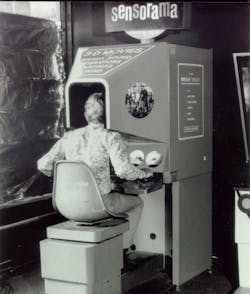This file type includes high-resolution graphics and schematics when applicable.
Augmented reality (AR) enhances and expands your view of the real world with computer-generated outputs, including sound, video, graphics, or GPS data. Many people first became aware of it when Google Glass arrived a few years ago, and augmented really hit the mainstream this last summer when Pokémon Go took off. AR has exciting implications for everything from education, defense, healthcare, and advertising, to construction, automotive, games, and much more.
Coupled with its cousin, virtual reality — which instead of offering you a hybrid universe, submerges you in an alternate, computer-created world — AR will be a ubiquitous force in the coming decade. It will be as pervasive and transformative as the internet was two decades ago or the smartphone has been over the last 10 years. It will affect everything from the way you play to the way you work, take notes, and learn.
Heather Bellini of Goldman Sachs Research predicts that augmented reality will become an $80 billion market by 2025—the size of the desktop PC market today. More importantly, she expects it to transform and interact with almost every industry, both consumer and enterprise.
AR’s move to an articulated natural web experience has already started, and promises to extend AR expectations even further. If you’re still trying to figure out how to incorporate AR into your products, or simply hoping to better understand how it’s already being used for mundane tasks today, here are six things you should know:
1. AR has a long history: As far back as 1957, there was a machine called the Sensorama (see below). It blew wind on you and vibrated the seat you sat on and immersed you in 3D film with stereo sound. In 1966, Ivan Sutherland invented the head-mounted display, which augmented real-world perspectives with computer data. The technology was first named “augmented reality” by Tom Caudell, a Boeing researcher who used it to describe displays that blended virtual graphics onto a physical reality in order to help aircraft electricians do their work.
2. AR is happening now: As noted above, augmented reality has been around in one form or another for almost 50 years, but is now fueled by computing and sensory technology that has improved 1000-fold in cost/performance in the past decade. AR is already in wide use today, for all kinds of mundane but important tasks. Industrial workers use it to find and assemble equipment:
Sportscasters use it to better narrate events:
and if you’ve watched the Olympics you’ve surely used augmented reality yourself:
It soon will become commonplace in our lives. If you don’t already have a head up display built into your car— i.e., a projection onto your windshield of information from your car’s gauges, including speed, available fuel, so you can be informed without having to take your eyes off the road – you will soon:
No one needs to wait another generation for augmented reality. It’s here now.
3. AR increases learning and deepens impressions: The brain absorbs things 33% more effectively when exposed to the immersive atmosphere of AR and VR, according to Stanford University Virtual Human Interaction Lab researcher Jeremy Bailenson. Moreover, people exposed to the “embodied cognition” of AR and VR are 20% more likely to change behavior by experiencing the impact of their decisions. This implies not only that students and employees will be able to learn faster and comprehend things more quickly in the future, but that AR is a great tool to build brand affinity and deepen brand loyalty.
4. AR is not too expensive: It’s becoming cheaper to implement AR into product development. AR benefits from the exponential treadmill of Moore’s Law, whereby the number of transistors doubles about every two years.
For example, in the year 2000, a 1-TFLOPS super computer was the world’s fastest. It cost $46 million, consumed 850 kW, and required a space of 1,600 sq. ft. to house it. In the year 2015, Nvidia announced a 2.3-TFLOPS computing board that consumed just 15 W and cost only $59—a technology improvement of 1 million. Several technologies are on the same cost reduction curve, thus enabling rapid AR deployment in form factors and cost points not possible two decades prior.
With the launch of software such as Vuforia Studio Enterprise, it’s no longer necessary for companies to employ code experts to implement AR. Vuforia Studio combines the 3D assets of tools like Creo and IoT data from ThingWorx with its own 3D-modeling tools, animations, and sequences that simplify the creation, operation, and servicing of connected products.
New offerings from companies such as Total Immersion, Arpa Solutions, AR Tookit, Orbotix, and 13th Lab promise to make enterprise deployment of AR solutions easier and cheaper. Here's a video from 13th Lab about one of its innovations:
Some free and low-cost AR apps are available for just a few hundred dollars, and it’s possible to create an entire AR mobile app for as little as $5,000. Large-scale custom deployments, however, can run into the tens of thousands of dollars or more.
5. People are still suspicious—is the market ready?: AR is not value-neutral. Vendors have found that you can’t change the world too radically for people without invading on some existing values and protocols. Google put a tremendous effort into the launch of Google Glass, but it never gained widespread popularity among consumers. It was largely due to the fact that people felt annoyed by the possibility of another person using Google Glass to spy on them or record their conversation.
The lesson for marketers is to be very careful. Any sort of technology that adds or changes perspective on the world potentially has social and even political implications, and can cause backlash. Much of the legal conversation about how to allow and monitor augmented reality is still in its infancy. In general, most AR products are assistants or bot-like functions that are appreciated by users because they provide the personal service and benefit.
6. AR will use multimodal inputs: AR promises to aid us in many ways, but how will it change the ways humans interact with computers? For the most part, it will expand and optimize the ways we can choose to interact with computers. Increasingly, we’ll be able to choose from a growing variety of input options depending on what’s most convenient for the task we’re working on in the location we’re working in.
Many AR solutions are built to respond to virtual buttons or voice commands. Today, voice is a common means of manipulating AR technologies, but in the future, we’ll see far more options. AR offers the potential for all sorts of input possibilities—from a keyboard or stylus to a finger stroke, gesture, or even eye movement. My own company, MyScript, is a leader in handwriting technology, and envisions multimodal inputs where virtual writing—either cursive or character—can be superimposed on and integrated with keyboard input, multi-line input, and voice input.
Moreover, you’ll not only be able create and interpret text when interacting with machines, you’ll also be able to include charts, diagrams, and math equations in an AR environment. MyScript’s Interactive Ink management technology has been built with this future in mind, in order to more fully immerse users in AR environments and address ever-more challenging applications.
With the widespread use of AR just beginning to reach consumers less than 10 years ago, augmented reality is just beginning to hit its stride. The current, growing enthusiasm for AR will really begin to take off and soon envelop your entire world, as databases of rich information expand and the speed and ease of connections to them accelerates further.
Tim Cook, Apple’s CEO, recently told Good Morning America that he thinks AR will be bigger than VR: “My own view is that augmented reality is the larger of the two, probably by far, because this gives the capability for both of us to sit and be very present talking to each other, but also have other things visually for both of us to see." In other words, AR won’t so much take us away to another world, but help us live more fully and productively in this one.






